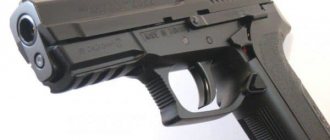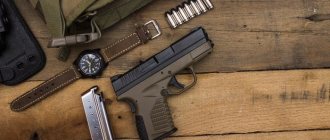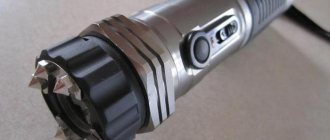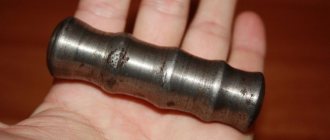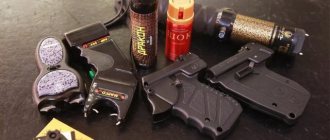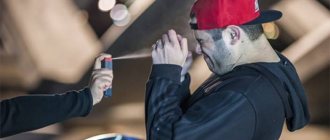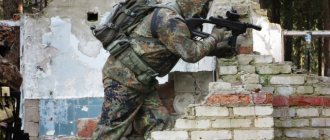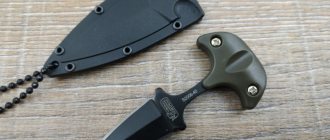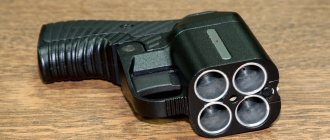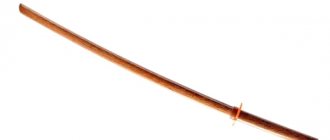Even a chimpanzee can beat an opponent with a stick. What can we say about modern police officers? An ordinary stick (nowadays it is most often made of rubber) is the simplest and most effective weapon used by police all over the world. There are two main types of "police baton":
- just a straight stick;
- stick with a perpendicular additional handle.
Both of them are widespread, both have their own specific application, their own design and technological features.
How to use different types of clubs for self-defense?
Today, probably each of us has thought about the need to purchase a means of self-defense.
Their diversity allows you to choose exactly the option that suits your characteristics. The buyer has access to all kinds of gas cartridges, AU, stun guns and others. Batons, having many advantages over similar products, are becoming increasingly popular. After all, it is with the help of a baton that you can resist an unexpected attack, as well as use it for its intended purpose when attacking animals. However, the specifics of its use require knowledge of some subtleties that will allow you to make the most of the capabilities of this means of self-defense.
Do I need a permit for a telescopic baton?
The carrying and use of rubber truncheons by private security service employees has become a common occurrence for us today.
At the same time, not all Russian citizens have an accurate idea of the exact purpose of this special security equipment and its types.
Also, few people have detailed information about the possibilities of using rubber batons by security guards and police officers and the legislative framework that regulates this area.
Our article provides a detailed description of a rubber stick as a special security device. Its main types and legal norms governing the use of a police baton are noted here.
The review also describes some techniques for effectively using a rubber stick as a weapon of self-defense.
All information was provided by employees of the private security company Legis, who have professional training and extensive experience in the use of rubber sticks and tonfas when providing security services in Moscow, St. Petersburg and Krasnodar.
Rubber stick for a security guard: general description
A rubber stick (baton) is a special security device used for active defense. According to the legislation of the Russian Federation, it is included in the ammunition of police officers and private security guards. Rubber batons are used for self-defense when repelling an attack, as well as when detaining an intruder who offers physical resistance.
The structure of the rubber baton is a molded rod made by vulcanization. At one end there is a handle with a lanyard. Some models of the rubber stick use an additional perpendicular handle. This variety is designed in the likeness of the tonfa, a traditional bladed weapon used in martial arts.
Rubber sticks, like other special security equipment (for example, handcuffs) are an integral part of ammunition. Therefore, special hard cases or rings attached to the belt are used to carry them. You can obtain more detailed information on the characteristics of rubber batons from our specialists by filling out an application for the provision of security services.
Flanking with a whip?
The checker and whip are not intended for flanking - they are not used to beautifully draw “eights” in the air. Real fighters know that they don’t fencing with checkers, they chop with them, and they don’t twirl whips in the air, but hit. An attempt to fencing with a saber with an opponent will end with the amputation of fingers, since she does not have a guard, and then with a severed head.
The same attempt to beautifully twirl a whip in front of a bandit or a dog will end in bites or a broken face. Actually, all flanking with checkers and whips comes down to demonstration performances in public and warming up the wrist before the real thing.
Practice and technique for outdoor use
Telescopic baton ESP 21′ in the hands of a Czech customs officer, 2010s.
First, let's look at the baton itself; The point is that it is not officially included among the legal means of self-defense in the CIS countries. So, carrying a “telescope” of any design and quality in these countries may raise questions among law enforcement officers, since this is an item originally intended to cause harm to a person; here the explanation as with a knife (for example, “needed for household needs”), with a “telescope” will not work so easily (although there have been cases when the explanation “I use it for training a dog, I’m going for a walk” turned out to be quite convincing). However, they are sold in markets, you can order them online and then wear them at your own risk.
Let's move on to the telescopes themselves. Here it is necessary to note the most important aspect: most of what you can buy or order are not high-quality weapons, since they are made either of plastic or soft iron - which is understandable, since batons made of hardened metal are definitely shock - crushing bladed weapons, are in service with law enforcement forces (in Germany, for example; not in the Russian Federation) and entail many problems for sellers of such weapons, including criminal liability, if they come across their goods in the field of view of law enforcement agencies.
Special forces squad with telescopic batons.
“Telescopes” that are not hardened steel, when used harshly in the unfolded state, essentially become disposable. After the first serious use, an untempered baton bends, loses its shape and becomes unsuitable for use. The only exception is when hitting very soft tissues (for example, the abdomen) or a moving object (that is, in the absence of hard contact). Nevertheless, as part of a general educational program, let’s talk about the technique of using a telescope.
It can be used in three ways:
Medium length batons
JAPAN. Medium-length police sticks were first used by police officers in feudal Japan during the Edo period (1603-1868). Japanese police officers (yoriki) were armed with a metal stick - jutte (“Ju” - ten, “Te” - hand; “Jutte” - the strength of ten hands).
Clubs, USA
The jutte was made of metal, had a handle and a striking part in the form of a round or multifaceted rod. Between the handle and the striking part there was an appendage in the form of a hook - kaga. A lanyard with a colored brush was attached to the ring on the handle, the color of which depended on the rank of the policeman. The length of the jutte, as a rule, corresponded to the length of the owner’s arm (about 50 cm), the length of the kaga was about 5 cm, and the diameter of the shaft was 1.5 cm.
The shape, size and decoration of the jutte were very diverse. In addition to the purely utilitarian form in the form of a metal rod with a hook, which was used by the lower ranks of the police, there were examples of a wide variety of shapes, sizes and finishes. Some jitte had a guard - tsuba, like on samurai swords, and could be decorated with inlay. Such a wide variety of jutte forms was due to the fact that they had a dual purpose. Firstly, it was a police weapon, and secondly, the jutte served as a symbol of the rank of officials in feudal Japan.
Circular blows with a tonfa baton
The origin of this weapon is still unclear. There is an opinion that the jutte was transformed from a specific weapon of the samurai - hachiwari (hachiwari - “breaking helmet”) - a sickle-shaped blade with a hook at the base of the handle (Fig. 8). This weapon was used in conjunction with a sword, similar to the sword and dagger in European fencing.
As a weapon, the jutte was intended to apprehend troublemakers without much bloodshed. Jutte made it possible to successfully defend against bladed weapons, and with the help of a kaga hook it was possible to capture or break the enemy’s blade. The kaga hook could also be used to grab an opponent's clothing or fingers.
Some police forces and individual police officers in Japan continued to use the jutte into the 1920s.
In 1947, a group of masters of jujitsu, karate and kendo (sword fencing) created a system of police hand-to-hand combat - taiho-jutsu.
Along with self-defense techniques without weapons, the use of a Japanese tanto knife in combat, special techniques of tying, escorting and searching, taiho-jutsu also includes techniques of fighting with a long (keijo) and medium (keibo) police baton.
Baton Hand-shock
The keibo baton was introduced into service by the Japanese police in 1946. Keibo was a wooden club or stick about 50 cm long and was traditionally used in Japanese martial arts as a training tool for strengthening the hands and practicing techniques for wielding a short bladed weapon and a metal fan - tesen. Subsequently, instead of them, sticks about 60 cm long began to be used, and starting in 1956, short batons, similar to the batons that were in service with the US Coast Guard at that time.
In 1961, for use in special forces of the Japanese police, an automatic telescopic stick was developed - toku-shi keibo, the shape of which is somewhat reminiscent of a jutte. By 1965, Shigimitsu Takaji, together with hand-to-hand combat instructors Kuroda Ichitaro and Kaminoda Tsunemori, finally formed a system of combat with tokushi keibo. The basis of this system consists of blows from above on the hands, shoulders, blows from the inside out to the body, punching blows to the sun
plexus, as well as escort techniques. It should be noted that head impacts are not used in this system to prevent serious injury.
The small size of the tokushi keibo when folded makes it possible to carry it concealed.
EUROPE and USA. In Europe, medium-length batons first appeared in police service in England during the reign of Queen Victoria (1837-1901). London police were armed with short wooden clubs about one foot long with a belt loop on the handle - "billy-clubs" or police batons (truncheons). The shape of the batons remained unchanged for almost a century, only in the 1930s they began to be made of rubber.
Batons made from rubber provide a softer blow than batons made from hard materials. Part of the kinetic energy during an impact is spent on deformation of the rubber (bending and compression), as well as rebound from the object during the impact.
American police officers used medium-length batons, which were somewhat different in shape from the batons of their Old World counterparts.
Until the early 1960s, there was virtually no dedicated baton-based self-defense system for police and law enforcement officers in the United States. In some departments, police officers were not trained in baton fighting at all. The newcomer was simply handed a baton and joked: “This is for you, guy, instead of brains.” In other departments, police officers were taught techniques ill-suited to the baton, borrowed from army bayonet fighting or fencing. As a result, the usual use of batons by police was little different from their use by a caveman - they simply hit the offender hard on the head until he lost all ability to resist.
Contact CIA
The Office of Public Affairs (OPA) is the single point of contact for all inquiries about the Central Intelligence Agency (CIA).
We read every letter, fax, or e-mail we receive, and we will convey your comments to CIA officials outside OPA as appropriate. However, with limited staff and resources, we simply cannot respond to everyone who writes to us.
Contact Information
By postal mail:
Central Intelligence Agency Office of Public Affairs Washington, DC 20505
Before contacting us:
Please check our site map
,
search
feature, or
our site navigation on the left
to locate the information you seek. We do not routinely respond to questions for which answers are found within this Web site.
Employment:
We do not routinely answer questions about employment beyond the information on this Web site, and we do not routinely answer inquiries about the status of job applications. Recruiting will contact applicants within 45 days if their qualifications meet our needs.
- Because of safety concerns for the prospective applicant, as well as security and communication issues, the CIA Recruitment Center does not accept resumes, nor can we return phone calls, e-mails or other forms of communication, from US citizens living outside of the US . When you return permanently to the US (not on vacation or leave), please visit the CIA Careers page and apply online for the position of interest.
- To verify an employees' employment, please contact the Employment Verification Office.
Self-defense in confined spaces
Quite often, attacks occur in a confined space: on a landing, elevator or entrance, where there is nowhere to turn around, there is no room to swing. Strikes for self-defense in a cramped room must be sharp, accurate, and very, very effective. In addition to kicking the groin, you can punch in the throat .
A side elbow strike can be called very effective and spectacular You should hit the temple or jaw.
The blow is delivered suddenly and very sharply, and it is advisable to turn the body, but even without this turn the enemy will receive severe injuries. Light blows, like clapping your palms, are strictly contraindicated in a street fight;
Police stick (baton)
In 1961, Robert Koga began teaching self-defense techniques at the Los Angeles Police Academy. By this time, he had almost 20 years of experience in judo, jiu-jitsu, aikido, as well as 5 years of experience in the Los Angeles Police Department for combating drug trafficking.
Robert Koga revolutionized the field of training in arresting and escorting troublemakers. He introduced a self-defense system into the police training program, created on the basis of traditional martial arts techniques, which allows one to effectively take control of even a superior enemy.
The Koga system was based on aikido techniques, as well as some techniques from judo, jiu-jitsu and freestyle wrestling, which he thoroughly reworked, adapting them to the real conditions in which police officers had to operate (similar work had been carried out many decades earlier by the founders of the domestic self-defense system and hand-to-hand combat - SAMBO - Viktor Afanasyevich Spiridonov and Vasily Sergeevich Oshchepkov).
In addition, Koga introduced a new type of baton - a smooth wooden stick, which became known as the "Koga stick". Unlike the sticks commonly used in jujutsu (bo and jo), the ends were rounded to minimize the risk of serious injury. When creating this weapon, Koga strived for maximum simplicity.
In his opinion, a police baton serves, firstly, to stop an attacker (including one armed with a bladed weapon) while at a safe distance, and secondly, it is a “force equalizer” in the event of a collision with a much more powerful enemy , or when defending against a group attack. According to Koga, a simple stick is best suited for this.
Basic Tonfa Baton Grips
The original length of the Koga stick was 66cm. Subsequently, depending on the height of the policeman, sticks with a length of 66 to 74 cm began to be used in the Koga system.
Robert Koga created a completely new baton training program. His system included blows and pokes (including those when the baton is held with both hands), blocks, methods of quickly snatching the baton (snatching and block/strike are performed in one continuous movement), as well as knocking down techniques and escort techniques. In the Koga system, much attention is paid to maintaining a safe distance and the correct selection of the affected area on the enemy’s body. The main areas for attack are the attacker's arms and legs, and strikes above the shoulder line are not used.
This arsenal of techniques allowed the policeman to effectively defend himself and make an arrest without beating his opponent half to death. Initially, the system of self-defense and working with a baton had no name. Koga usually referred to it as "self-defense for police officers" or "arrest technique." But in 1968, he published the first textbook on his system, and therefore chose the name “Kog method” for it. Koga later named his style "Koga-taiho-jutsu", then settled on "Koga-jutsu".
Unlike most other police systems, Koga-jutsu is not a set of heterogeneous techniques, but a clear system of physical and psychological interaction with the offender, built on the basis of certain psychological, tactical and technical principles.
The Koga system served as a model for the creation of many other modern police self-defense systems.
Traditional tonfa (left) and its police version (right)
At the end of the last century, the famous Israeli hand-to-hand combat expert Amnon Maor, creator of the KMM (Krav Maga Maog) hand-to-hand combat system, or KAMAM, developed a new effective and compact strike-type weapon - the hand-shock. The effectiveness of hand-shock is due to its specific form, which allows it to cause sharp pain with minimal physical effort, without injuring the offender.
Based on the hand shock, Maor developed new types of small and medium police sticks.
Legal aspects
In some countries, telescopic batons are produced industrially and are used by police units. In Russia, Ukraine, Belarus, and Estonia, free circulation of telescopic batons is prohibited, and in the vast majority of cases, homemade products are found. The telescopic baton belongs to the class of bladed weapons with shock-crushing action, and at the moment, criminal liability in the Russian Federation remains only for the sale and manufacture of bladed weapons. Administrative liability applies for carrying.
When investigating criminal cases involving bodily harm, the use of a telescopic baton is an aggravating circumstance for the court, like the use of a prohibited type of bladed weapon, and usually leads to an increase in the term of imprisonment.
Advantages and disadvantages
The disadvantages of police batons are a direct extension of their advantages.
The relatively low power of the baton as a hand-held weapon with shock-crushing action is both its disadvantage and its advantage.
This is a disadvantage because this weapon does not have much impact. Doesn't kill a person. Usually its use does not even cause a person to lose consciousness. It causes relatively little damage to the health of the attacker. Yes, this is a drawback. The gun is much more effective.
But at the same time, low power is a very important advantage of the baton. She leaves the intruder alive. Does not deprive him of his ability to work. The purpose of this weapon is not to kill a person, but to force him to change his behavior: leave an unauthorized meeting, stop a domestic fight, obey the order of a government official.
And the baton copes with its tasks very well.
So is it possible or not?
Of course, you can use edged weapons as a means of self-defense if they are manufactured according to the standards established by GOST. All that remains is to get a license from the police, buy a gun, register as a hunter and, of course, be over 18 years old. There are no such problems with a whip or a spinner. The whip does not have to be worn as part of the national costume. If you are not registered in the Cossack register, but in the evenings you like to walk with a saber and a cloak on your shoulders, then the police will take away the saber one hundred percent, but not the whip.
In Russia, the circulation of impact-crushing weapons is prohibited, that is, nunchaku, flails, or clubs will be illegal, but not the whip in its historical design - without metal cables inside and lead in the slap. You cannot send bladed weapons by mail and make them - you can also be punished for this, but, again, this does not apply to whips.
